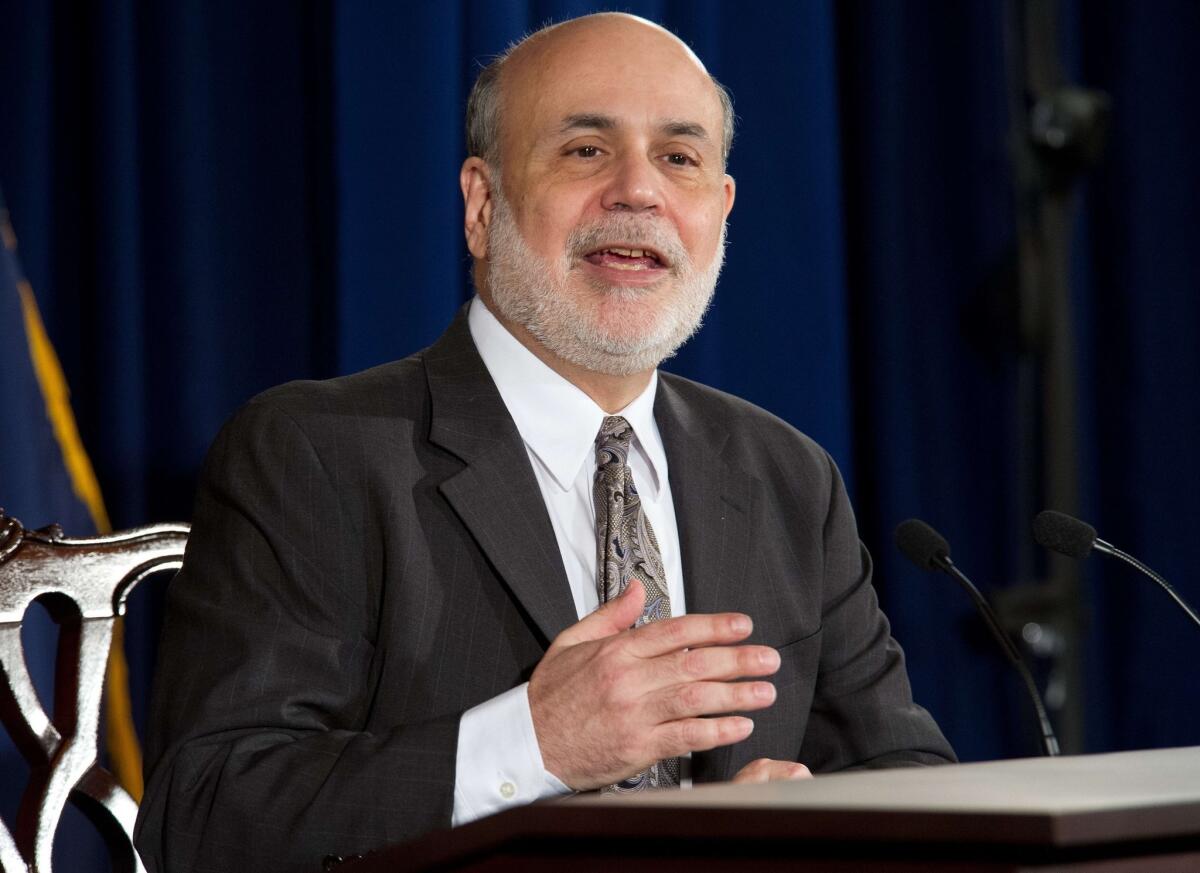Alexander Hamilton fans are upset about his demotion on $10 bill

Ben S. Bernanke, former Fed chairman, is “appalled” by Hamilton’s $10 bill demotion.
- Share via
reporting from washington — The historic gain for women in landing a promised spot on U.S. paper currency stands to be a big loss for one founding father — and his supporters aren’t pleased.
The announcement that a woman would grace a greenback for the first time in more than a century has been widely applauded. But the decision by Treasury Secretary Jacob J. Lew to place the yet-unnamed female on the $10 bill, which for more than eight decades has featured Alexander Hamilton, is drawing a sharp backlash.
Former Federal Reserve Chairman Ben S. Bernanke said he was “appalled” that Hamilton — the first Treasury secretary and, “without doubt, the best and most foresighted economic policymaker in U.S. history” — was being demoted.
New York Atty. Gen. Eric T. Schneiderman also urged Lew publicly to “honor Hamilton by leaving him where he is.”
Columnists and editorial boards have made similar pleas. Hamilton fans have established #SaveHamilton on Twitter. And two petitions have been launched on the White House website urging President Obama to keep Hamilton as the face of the $10 bill.
Even the head of the organization that has been pushing for a woman’s image to be placed on paper currency — it preferred the more ubiquitous $20 bill — said she didn’t want the victory to come at Hamilton’s expense.
“We certainly had not set out to displace one of our great founders and architects of our country,” said Barbara Ortiz Howard, founder of Women on 20s. “That wasn’t our intention.”
Lew said that Hamilton’s image still will be on the $10 bill in some way and that the decision about which denomination would feature a woman was made based on the next bill scheduled for an update.
“Alexander Hamilton has left an enduring mark on our nation’s history,” Lew said in a speech at the National Archives this month. “That is why we will make sure that his image will remain a part of the $10 note.”
Howard said her group wouldn’t be pleased if a woman has to share the $10 bill with a man.
And Hamilton’s supporters said he is too important in American history to be relegated to a secondary position. Some have wondered if Hamilton’s image could be reduced to a security watermark that could be seen only by holding up the bill to a light, said Rand Scholet, a Florida businessman who founded the Alexander Hamilton Awareness Society in 2011 to promote his life and legacy.
“It is hard to understand that the current secretary of the Treasury would diminish the first secretary of the Treasury,” he said. “It’s really baffling.”
Hamilton’s supporters admit he’s not the most well-known founding father. He never was elected president and died relatively young, before he turned 50 after a duel with then-Vice President Aaron Burr.
“I think Hamilton has historically been under-appreciated, and because he’s a non-president, he might have been seen as somewhat of an easy target,” said Pooja Nair, a Los Angeles lawyer and president of the society’s California chapter.
What really frustrates Hamilton backers is that he has a strong claim to a spot on paper money because he’s widely viewed as the father of the nation’s financial system.
After arriving in America as a poor orphan from the West Indies, Hamilton rose to become a trusted aide to George Washington during the American Revolution and a major force in ratification of the U.S. Constitution.
As Treasury secretary, Hamilton consolidated the war’s debts, set up a tax-collection system and introduced plans for the U.S. Mint.
Bernanke pointed out in a post on his blog this week that Hamilton founded the nation’s first major private bank and also oversaw the controversial chartering of the First Bank of the United States, a precursor to the Federal Reserve.
On the other hand Andrew Jackson, whose image is on the $20 bill, was an outspoken opponent of a central bank and paper currency.
On top of that, there’s the character issue: Jackson has been vilified for his poor treatment of Native Americans, while Hamilton has been held up as an early abolitionist.
To Bernanke and others, the solution is clear: keep Hamilton on the $10 bill and let a woman replace Jackson on the $20 bill.
But it’s not that simple.
Two years ago, the Treasury’s Advanced Counterfeit Deterrence program recommended that the $10 bill be the next denomination redesigned. The new bill will be unveiled in 2020, the 100th anniversary of the Constitutional amendment granting women the right to vote, Lew said. If a woman were to be put on the $20 bill instead, the wait would be longer.
In addition to anti-forgery protections, the $10 bill is slated to get a new tactile feature to allow blind and visually impaired people to distinguish it from other denominations, the Treasury said. Because there are fewer $10 bills in circulation than $20 bills, it’s a better denomination to test the new feature.
“The reason that the …Treasury Department has selected the $10 bill is the $10 bill is currently the one that is under review by the appropriate authorities for upgraded redesign for security purposes,” White House Press Secretary Josh Earnest said this week when asked if Obama had a view on the controversy. “And that is why the discussion is happening in the context of the $10 bill.”
Scholet said he’d be happy if Treasury decided to produce two versions of the $10 bill — one with Hamilton and the other with a woman. Howard said that would be OK with her, too. And Lew hasn’t ruled out that possibility.
“We have to find a way to continue to honor Hamilton, but at the same time start recognizing that women are fundamental in our society,” she said.
More to Read
Inside the business of entertainment
The Wide Shot brings you news, analysis and insights on everything from streaming wars to production — and what it all means for the future.
You may occasionally receive promotional content from the Los Angeles Times.











